Arecanut Diseases
Arecanut Diseases
Koleroga/mahali/fruit rot/bud rot
Disease symptoms:
- Characteristic symptom is rotting and extensive shedding of the immature nuts which lie scattered near the base of the tree.
- Initial symptoms appear as dark green/ yellowish water-soaked lesions on the nut surface near the perianth (calyx).
- The infected nuts lose their natural green lusture, quality and hence have a low market value.
- The lesions on the fruits gradually spread covering the whole surface before or after shedding which consequently rot.
- White mycelial mass envelopes on entire surface of the fallen nuts.
- As the disease advances the fruit stalks and the axis of the inflorescence rot and dry, sometimes covered with white mycelial mats.
- Infected nuts are lighter in weight and possess large vacuoles.
- When infection occurs later in the season, it leads to rotting and drying up of nuts without shedding (known as ‘Dry Mahali’).
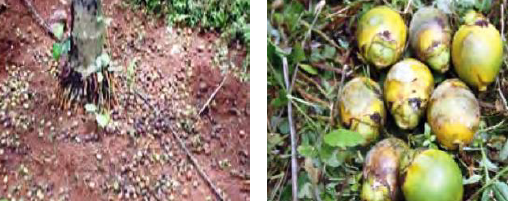
Survival and spread:
- Disease spreads through heavy winds and rain splashes.
- The fruit bunches infected towards the end of rainy season may remain mummified on the palm and such nuts provide inoculum for bud rot or crown rot or the recurrence of fruit rot in the next season.
Favourable conditions:
- The severity, persistence and spread of fruit rot are related to the pattern of rain. The disease appears usually 15 to 20 days after the onset of regular monsoon rains and may continue up to the end of the rainy season.
- Continuous heavy rainfall coupled with low temperature (20 to 23 °C), high relative humidity 90%) and intermittent rain and sunshine hours favour the outbreak of fruit rot
Inflorescence die back
Disease symptoms:
- Disease appears on rachillae of the male flowers and then in the
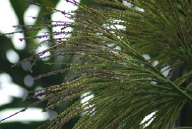 main rachis as brownish patches which soon spreads from tip downwards covering the entire rachis causing wilting.
main rachis as brownish patches which soon spreads from tip downwards covering the entire rachis causing wilting. - The female flowers of the infected rachis shed and the whole inflorescence shows ‘die back’ symptom.
- The fruiting bodies of the fungus (conidia) appear as concentric rings in the discolored areas.
- The disease is severe mostly during dry condition (February-March).
- Button shedding followed by die-back of inflorescence is a severe problem in arecanut plantations during monsoon periods.
Survival and spread:
- Spread is through air borne conidia.
Yellow leaf disease
Disease symptoms:
- Yellowing of tips of leaflets in 2 or 3 leaves of outermost whorl.
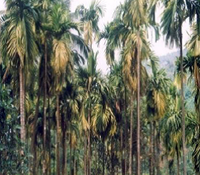
- Brown necrotic streaks run parallel to veins in unfolded leaves.
- The yellowing extends to the middle of the lamina. Tips of the chlorotic leaves dry up. In advanced stage all the leaves become yellow.
- Yellowing of leaves is conspicuous during October to December.
- Finally the crown leaves fall off leaving a bare trunk. Root tips turn black and gradually rot
Survival and spread:
- Phytoplasma Like Organism (Phytoplasma)
- Vector: Plant hopper (Proutista moesta)
Anabe roga/foot rot
Disease symptoms:
- The leaf lets in outer whorls become yellow and spreads to the whole leaf and the leaves droop down covering the stem.
- Later, the inner whorl leaves also become yellow. Subsequently all the leaves droop, dry up and fall off, leaving the stem alone.
- Then the stem becomes brittle and easily broken by heavy wind.
- The base of the stem shows brown discoloration and oozing of dark fluid.
- Bracket shaped fructifications of the fungus called ‘anabe’ appears at the base of the trunk.
- Roots become discoloured, brittle and dried.
- When infected trunk is cut open brown discoloration can be seen up to one metre from ground level.
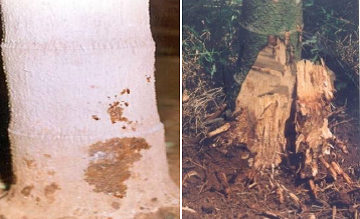
Survival and spread:
- The disease is severe in neglected, ill-drained and over-crowded gardens especially with hard, black loamy acid soils of higher iron and calcium contents.
- Soil borne, but secondary spread is through air-borne spores.
Bud rot
Disease symptoms:
- Initial symptom is the characteristic change of spindle leaf colour from green to yellow
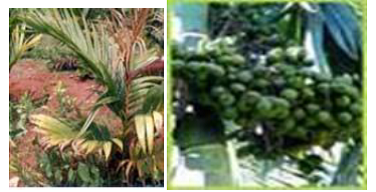 and then brownish.
and then brownish. - The leaves rot and the growing bud rots causing death of the palm.
- The affected young leaf whorl can be easily pulled off.
- The outer leaves also become yellow and droop down one by one leaving a bare stem.
Disease cycles
Anabe roga or foot rot
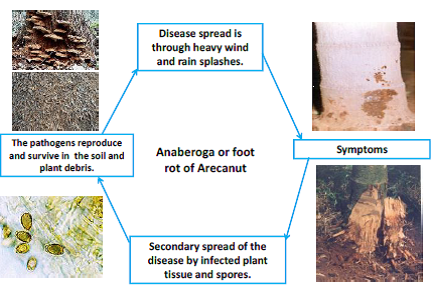
Bud rot
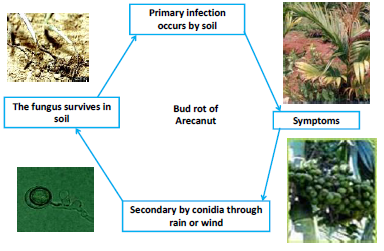
IPM for Arecanut
To know the IPM practices for Arecanut, click here.
Source: NIPHM, Directorate of Plant Protection, Quarantine & Storage
Last Modified : 3/22/2020
© C–DAC.All content appearing on the vikaspedia portal is through collaborative effort of vikaspedia and its partners.We encourage you to use and share the content in a respectful and fair manner. Please leave all source links intact and adhere to applicable copyright and intellectual property guidelines and laws.
RELATED ITEMS
Coriander Diseases
This topic provides information about Coriander D...
Broccoli Diseases
This topic covers information about Broccoli Descr...
Apricot Diseases
This topic provides information about Apricot-Desc...
Ber Diseases
This topic covers information about Ber Diseases.
